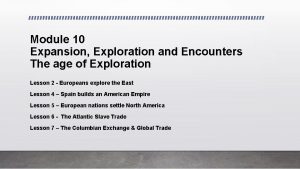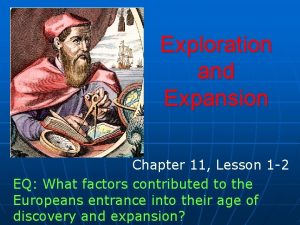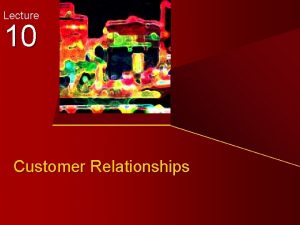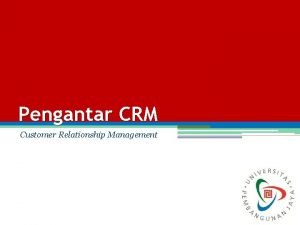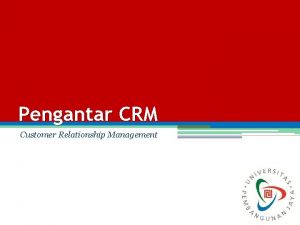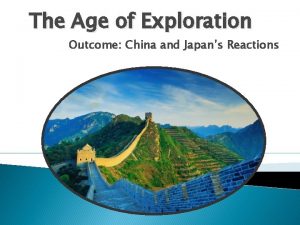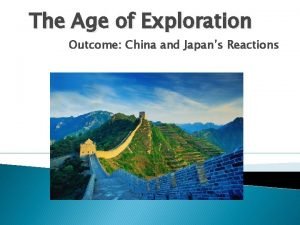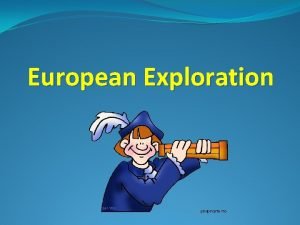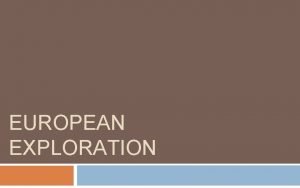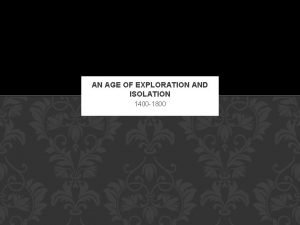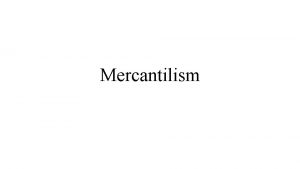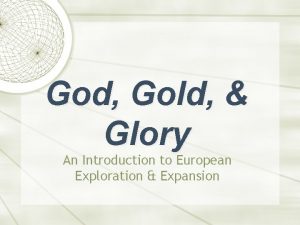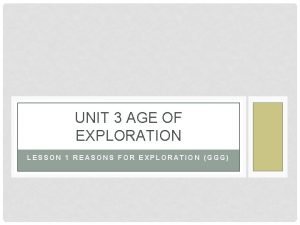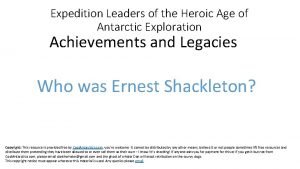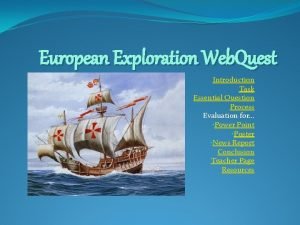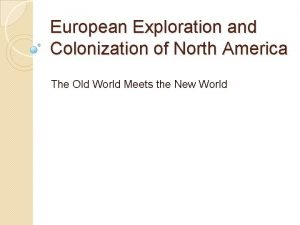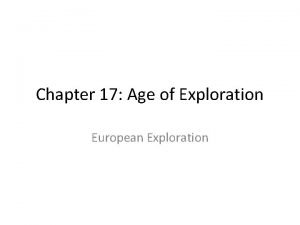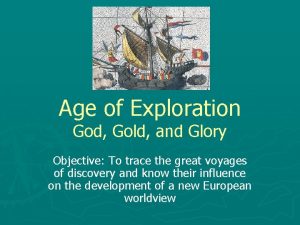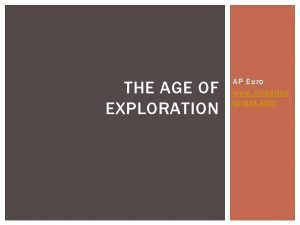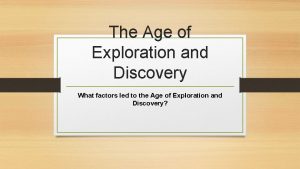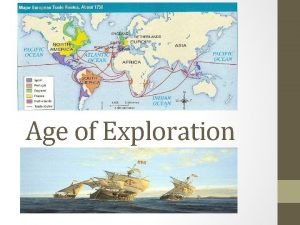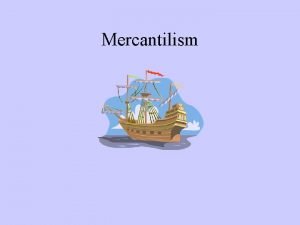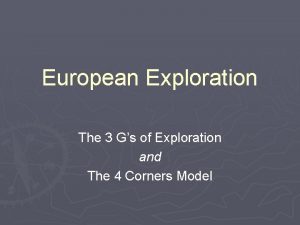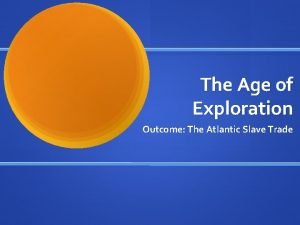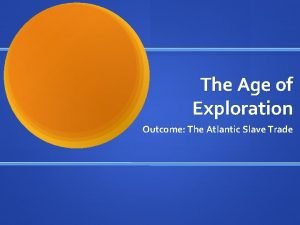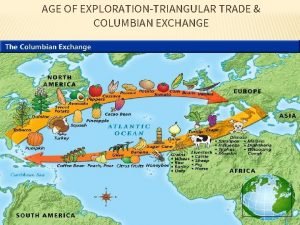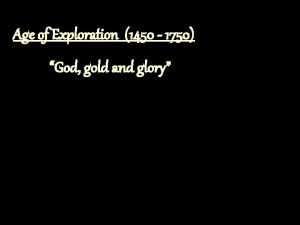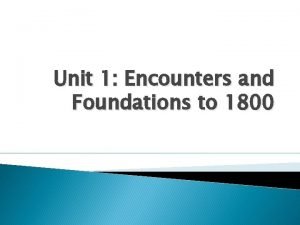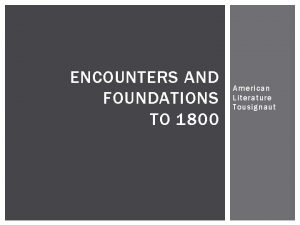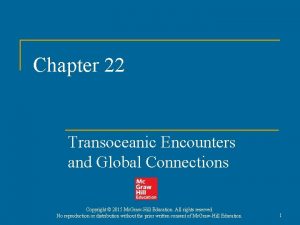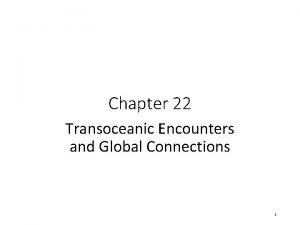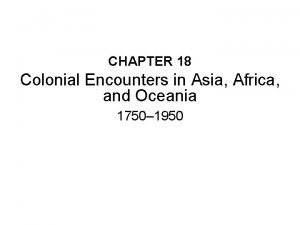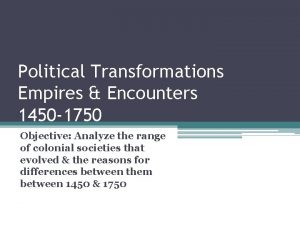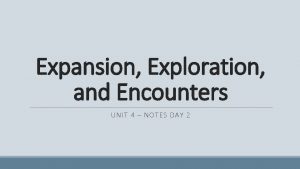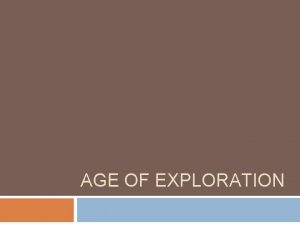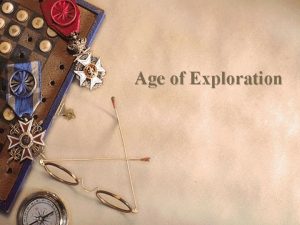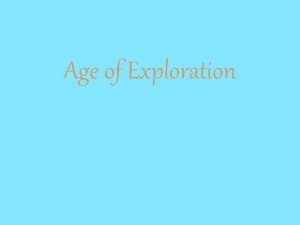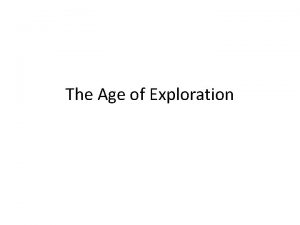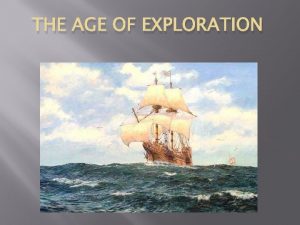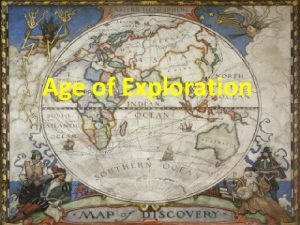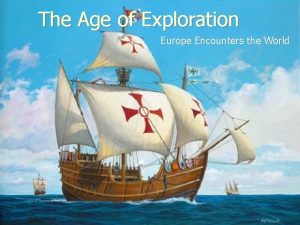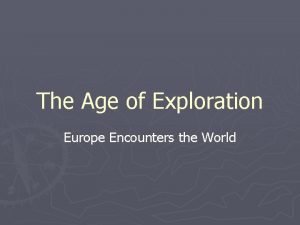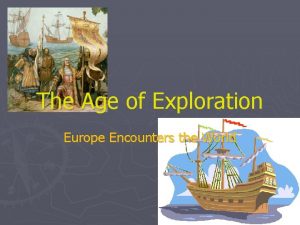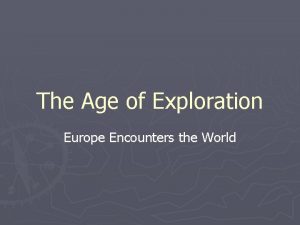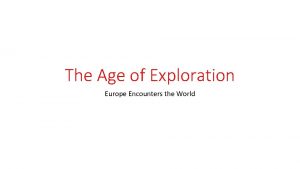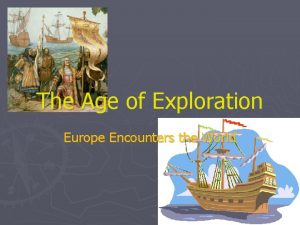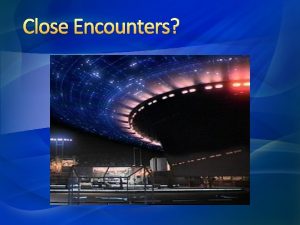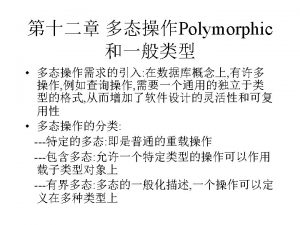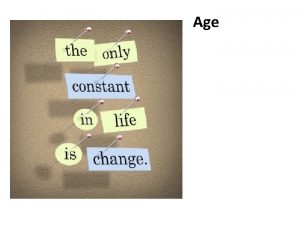Module 10 Expansion Exploration and Encounters The age










































- Slides: 42

Module 10 Expansion, Exploration and Encounters The age of Exploration Lesson 2 - Europeans explore the East Lesson 4 – Spain builds an American Empire Lesson 5 – European nations settle North America Lesson 6 - The Atlantic Slave Trade Lesson 7 – The Columbian Exchange & Global Trade

Europeans explore the East Lesson 1 • Advances in sailing technology enabled Europeans to explore other parts of the world. • By the early 1400 s, Europeans were ready to venture beyond their borders. The Renaissance encouraged, among other things, a new spirit of adventure and curiosity. This spirit of adventure, along with several other important factors, prompted Europeans to explore the world around them. This lesson describes how these explorations began a long process that would bring together the peoples of many different lands and permanently change the world.

Europeans Seek New Trade Routes For the most part, Europeans had neither the interest nor the ability to explore foreign lands. That changed by the early 1400 s. The desire to grow rich and to spread Christianity, coupled with advances in sailing technology, spurred an age of European exploration. The desire for new sources of wealth was the main reason for European exploration. Through overseas exploration, merchants and traders hoped ultimately to benefit from what had become a profitable business in Europe:

Europeans Seek New Trade Routes • The people of Europe had been introduced to these items during the Crusades, After the Crusades ended, Europeans continued to demand such spices as nutmeg, ginger, cinnamon, and pepper, all of which added flavor to the bland foods of Europe. • Because demand for these goods was greater than the supply, merchants could charge high prices and thus make great profits. • The Muslims and the Italians controlled trade from East to West.

Europeans Seek New Trade Routes • Muslims sold Asian goods to Italian merchants, who controlled trade across the land routes of the Mediterranean region. The Italians resold the items at increased prices to merchants throughout Europe. • Other European traders did not like this arrangement. Paying such high prices to the Italians severely cut into their own profits. By the 1400 s, European merchants—as well as the new monarchs of England, Spain, Portugal, and France—sought to bypass the Italian merchants. This meant finding a sea route directly to Asia.

The Spread of Christianity • The desire to spread Christianity also motivated Europeans to explore. The Crusades had left Europeans with a taste for spices, but more significantly, with feelings of hostility between Christians and Muslims. European countries believed that they had a sacred duty not only to continue fighting Muslims, but also to convert non-Christians throughout the world.

Technology Makes Exploration Possible • Advances in technology made the voyages of discovery possible. During the 1200 s, it would have been nearly impossible for a European sea captain to cross 3, 000 miles of ocean and return again. The main problem was that European ships could not sail against the wind. In the 1400 s, shipbuilders designed a new vessel, the caravel. The caravel was sturdier than earlier vessels. In addition, triangular sails adopted from the Arabs allowed it to sail effectively against the wind.

Technology Makes Exploration Possible Europeans also improved their navigational techniques. To better determine their location at sea, sailors used the astrolabe, which Islamic astronomers and mathematicians had perfected. The astrolabe was a brass circle with carefully adjusted rings marked off in degrees. Using the rings to sight the stars, a sea captain could calculate latitude, or how far north or south of the equator the ship was. Explorers were also able to more accurately track direction by using a magnetic compass, a Chinese invention.

Portugal Leads the Way The Portuguese are credited with perfecting a 16 -point wind rose. A wind rose was a tool that showed from which direction the wind was blowing. Measurements obtained from these tools, as well as observed ocean current patterns, were written down in pilot books, or navigation charts, for use during future voyages. The leader in developing and applying these sailing innovations was Portugal was the first European country to establish trading outposts along the west coast of Africa. Eventually, Portuguese explorers pushed farther east into the Indian Ocean.

Portugal Leads the Way Portugal took the lead in overseas exploration in part due to strong government investment. The nation’s most enthusiastic supporter of exploration was Prince Henry, the son of Portugal’s king. For his role in promoting Portuguese exploration, historians call Prince Henry “the Navigator. ” Although he never went on voyages of discovery, Henry was consumed by the quest to find new lands and to spread Christianity. Henry used his own fortune to organize more than 14 voyages along the western coast of Africa, which was previously unexplored by Europeans. As a result, Henry died in debt. The Portuguese crown spent more than 60 years paying off his debts.

Portugal Leads the Way The Portuguese believed that to reach Asia by sea, they would have to sail around the southern tip of Africa. In 1488, Portuguese captain Bartolomeu Dias ventured far down the coast of Africa until he and his crew reached the tip. As they arrived, a huge storm rose and battered the fleet for days. When the storm ended, Dias realized his ships had been blown around the tip to the other side.

Portugal Leads the Way With the tip of Africa finally rounded, the Portuguese continued pushing east. In 1497, Portuguese explorer Vasco da Gama began exploring the east African coast. In 1498, he reached the port of Calicut, on the southwestern coast of India. Da Gama and his crew were amazed by the spices, rare silks, and precious gems that filled Calicut’s shops. The Portuguese sailors filled their ships with such spices as pepper and cinnamon and returned to Portugal in 1499. Their cargo was worth 60 times the cost of the voyage. Da Gama’s remarkable voyage of 27, 000 miles had given Portugal a direct sea route to India.

Spain Also Makes Claims As the Portuguese were establishing trading posts along the west coast of Africa, Spain watched with increasing envy. The Spanish monarchs also desired a direct sea route to Asia. In 1492, an Italian sea captain, Christopher Columbus, convinced Spain to finance a bold plan: finding a route to Asia by sailing west across the Atlantic Ocean. In October of that year, Columbus reached an island in the Caribbean. He was mistaken in his thought that he had reached the East Indies. But his voyage would open the way for European colonization of the Americas—a process that would forever change the world. The immediate impact of Columbus’s voyage, however, was to increase tensions between Spain and Portugal.

Spain Also Makes Claims In 1493, Pope Alexander VI stepped in to keep peace between the two nations. He suggested an imaginary dividing line, drawn north to south, through the Atlantic Ocean. All lands to the west of the line, known as the Line of Demarcation, would be Spain’s. These lands included most of the Americas. All lands to the east of the line would belong to Portugal complained that the line gave too much to Spain. So it was moved farther west to include parts of modern-day Brazil for the Portuguese. In 1494, Spain and Portugal signed the Treaty of Tordesillas, in which they agreed to honor the line.

Trading Empires in the Indian Ocean In 1493, Pope Alexander VI stepped in to keep peace between the two nations. He suggested an imaginary dividing line, drawn north to south, through the Atlantic Ocean. All lands to the west of the line, known as the Line of Demarcation, would be Spain’s. These lands included most of the Americas. All lands to the east of the line would belong to Portugal complained that the line gave too much to Spain. So it was moved farther west to include parts of modern-day Brazil for the Portuguese. In 1494, Spain and Portugal signed the Treaty of Tordesillas, in which they agreed to honor the line.

Trading Empires in the Indian Ocean Beginning around 1600, the English and Dutch began to challenge Portugal’s dominance over the Indian Ocean trade. Pressure from Dutch and also English fleets eroded Portuguese control of the Asian region. The Dutch and English then battled one another for dominance of the area. Both countries had formed an East India Company to establish and direct trade throughout Asia. These companies had the power to mint money, make treaties, and even raise their own armies. The Dutch East India Company was richer and more powerful than England’s company. As a result, the Dutch eventually drove out the English and established their dominance over the region.

Vocab & Reading Checks Prince Henry Portuguese supporter of exploration Bartolomeu Dias Portuguese explorer who rounded the tip of Africa Vasco da Gama explorer who gave Portugal a direct sea route to India Treaty of Tordesillas treaty between Spain and Portugal dividing newly discovered lands between them Dutch East India Company Dutch company that established and directed trade throughout Asia

Vocab & Reading Checks How might the phrase “God, Glory, and Gold” summarize the Europeans motives for exploration? European explores wanted to spread Christianity, bring fame to themselves and their Country and become rich. How did Prince Henry’s experiences in Africa impact his decision to open a navigation school? The riches he seen in Africa motivated him, he wanted to teach and encourage Portuguese explorers to discover the source of riches and claim the land for Portugal. How did the treaty of Tordesillas ease tensions between Spain and Portugal? It appeased bot nations by granting them their own territories to colonize. How did the arrival of the Europeans affect the peoples of the east in general? It did not greatly affect them, European influence didn’t spread much beyond port cities of the East.

Spain Builds an American Empire Lesson 4 • The voyages of Columbus prompted the Spanish to establish colonies in the Americas. • Christopher Columbus made a daring voyage from Spain in 1492. Instead of sailing south around Africa and then east, Columbus sailed west across the Atlantic in search of an alternate trade route to Asia and its riches. Columbus never reached Asia. Instead, he stepped onto an island in the Caribbean. That event would bring together the peoples of Europe, Africa, and the Americas.

Spain Builds an American Empire Lesson 4 • The Niña, Pinta, and Santa María sailed out of a Spanish port around dawn on August 3, 1492. In a matter of months, Columbus’s fleet would reach the shores of what Europeans saw as an astonishing new world. • Columbus had miscalculated where he was. He had not reached the East Indies. Scholars believe he landed instead on an island in the Bahamas in the Caribbean Sea. • Columbus, like other explorers, was interested in gold. Finding none on Salvador, he explored other islands, staking his claim to each one.

Spain Builds an American Empire Lesson 4 • In early 1493, Columbus returned to Spain. The reports he relayed about his journey delighted the Spanish monarchs. King Ferdinand Queen Isabella, who had funded his first voyage, agreed to finance three more trips. Their sponsorship was a major motivation for Columbus to continue his explorations. • Columbus embarked on his second voyage to the Americas in September of 1493. He journeyed no longer as an explorer, but as an empire builder. He commanded a fleet of some 17 ships that carried over 1, 000 soldiers, crewmen, and colonists. • The Spanish intended to transform the islands of the Caribbean into colonies, or lands that are controlled by another nation. Over the next two centuries, other European explorers began sailing across the Atlantic in search of new lands to claim.

Spain Builds an American Empire Lesson 4 • The legacy of Christopher Columbus’s voyages is debated. Some argue he took heroic first steps in the creation of great and democratic societies, while others claim he launched an era of widespread cruelty, bloodshed, and epidemic disease.

Other Explorers Take to the Seas Lesson 4 • By the 15 th century, the political systems in Portugal, headed by King John II, gave strong support to exploration of the Americas. • In 1500, the Portuguese explorer Pedro Álvares Cabral reached the shores of modern-day Brazil and claimed the land for his country. A year later, Amerigo Vespucci (vehs • POO • chee), an Italian in the service of Portugal, also traveled along the eastern coast of South America. Upon his return to Europe, he claimed that the land was not part of Asia, but a “new” world. In 1507, a German mapmaker named the new continent “America” in honor of Amerigo Vespucci.

Other Explorers Take to the Seas Lesson 4 • In 1519, Portuguese explorer Ferdinand Magellan led the boldest exploration yet. Several years earlier, Spanish explorer Vasco Núñez de Balboa had marched through modern-day Panama and had become the first European to gaze upon the Pacific Ocean. Soon after, Magellan convinced the king of Spain to fund his voyage into the newly discovered ocean.

Other Explorers Take to the Seas Lesson 4 • With about 250 men and five ships, Magellan sailed around the southern end of South America and into the waters of the Pacific. The fleet sailed for months without seeing land, except for some small islands. Food supplies soon ran out. • After exploring the island of Guam, Magellan and his crew eventually reached the Philippines. Unfortunately, Magellan became involved in a local war there and was killed. His crew, greatly reduced by disease and starvation, continued sailing west toward home. Out of Magellan’s original crew, only 18 men and one ship arrived back in Spain in 1522, nearly three years after they had left. They were the first persons to circumnavigate, or sail around, the world.

Spanish Conquests in Mexico Lesson 4 • In 1519, a Spaniard named Hernando Cortés landed on the shores of Mexico. After colonizing several Caribbean islands, the Spanish had turned their attention to the American mainland. • Cortés marched inland, looking to claim new lands for Spain. Cortés and the many other Spanish explorers who followed him were known as conquistadors (conquerors). Lured by rumors of vast lands filled with gold and silver, conquistadors carved out colonies in regions that would become Mexico, South America, and the United States. • The Spanish were the first European settlers in the Americas. As a result of their colonization, the Spanish greatly enriched their empire and left a mark on the cultures of North and South America that exists today.

Cortés Conquers the Aztecs Lesson 4 • Soon after landing in Mexico in 1519, Cortés learned of the vast and wealthy Aztec Empire in the region’s interior. After marching for weeks through difficult mountain passes, Cortés and his force of roughly 600 men finally reached the magnificent Aztec capital of Tenochtitlán (teh • NAWCH • tee • TLAHN). It was there that Cortés and his men would engage the Aztec Empire and severely affect its culture, economy, and society. • The Aztecs controlled hundreds of smaller surrounding cities. They gained economic power by demanding annual payments from these conquered communities. The presence of the Spaniards disrupted this aspect of the Aztec way of life, as Cortés colonized many of these places. Furthermore, many of these cities were angry at the Aztecs, and as a result, were willing to ally themselves with Cortés as he took control of Tenochtitlán.

Cortés Conquers the Aztecs Lesson 4 • Cortés and his men conquered the Aztecs in 1521. • Several factors played a key role in the stunning victory. First, and most important, the natives could do little to stop the invisible warrior that marched alongside the Spaniards— disease. Measles, mumps, smallpox, and typhus were just some of the diseases Europeans were to bring with them to the Americas. • The Impact of Disease: Among the most disastrous effects of the arrival of Europeans in the Americas was the rapid spread of disease. The image shown here was drawn in the mid-tolate 1500 s by a Spanish missionary priest who had befriended many Aztecs. The image shows Aztecs suffering through various stages of smallpox.

Cortés Conquers the Aztecs Lesson 4 • Native Americans had never been exposed to these diseases. Thus, they had developed no natural immunity to them. As a result, they died by the hundreds of thousands. By the time Cortés launched his counterattack, the Aztec population had been greatly reduced by smallpox and measles. In time, European disease would truly devastate the natives of central Mexico, killing millions of them. • Second, Cortés was able to enlist the help of various native groups. With the aid of a native woman interpreter named Malinche, Cortés learned that some natives resented the Aztecs. They hated their harsh practices, including human sacrifice. Through Malinche, Cortés convinced these natives to fight on his side. • Finally, the Spanish had the advantage of superior weaponry. Aztec arrows were no match for the Spaniards’ muskets and cannons.

Spanish Conquests in Peru Lesson 4 • In 1532, another Spanish explorer, Francisco Pizarro, marched a small force into South America. He conquered the Incan Empire and destroyed its culture, economy, and society. • Pizarro and his army of about 200 met the Incan ruler, Atahualpa (AH • tuh • WAHL • puh), near the city of Cajamarca. Atahualpa, who commanded a force of about 30, 000, brought several thousand mostly unarmed men for the meeting. The Spaniards waited in ambush, crushed the Incan force, and kidnapped Atahualpa. The Spaniards then moved into the smaller surrounding cities that were under Incan control and plundered them of their gold and silver. Not only was this economically devastating for the Incan Empire, it was a cultural attack as well. The gold and silver adorned Incan temples and buildings, many of which were destroyed during the looting.

Spanish Conquests in Peru Lesson 4 • Just as the Aztec leader Montezuma sensed Cortés’s thirst for political and economic power, so did the imprisoned Atahualpa detect Pizarro’s motives. Atahualpa offered to fill a room once with gold and twice with silver in exchange for his release. However, after receiving the ransom, the Spanish strangled the Incan king. Also like Montezuma, Atahualpa’s body was burned, which was culturally forbidden by the Inca. • With these acts, the Spanish debilitated the Incan political organization. It signaled the beginning of the end of Incan culture. The remaining Incan force, demoralized by their leader’s death, retreated from Cajamarca. Pizarro then marched on the Incan capital, Cuzco. He captured it without a struggle in 1533. From Cuzco, Pizarro established a new government, which offered Incan lands to Spanish conquerors.

Spanish Conquests in Peru Lesson 4 • As Cortés and Pizarro conquered the civilizations of the Americas, fellow conquistadors defeated other native peoples. Spanish explorers also conquered the Maya in Yucatan and Guatemala. By the middle of the 16 th century, Spain had created an American empire. It included New Spain (Mexico and parts of Guatemala), as well as other lands in Central and South America and the Caribbean.

Spain’s Pattern of Conquest Lesson 4 • In building their new American empire, the Spaniards drew from techniques used during the reconquista of Spain. When conquering the Muslims, the Spanish lived among them and imposed their Spanish culture upon them. The Spanish settlers to the Americas, known as peninsulares, were mostly men. As a result, relationships between Spanish settlers and native women were common. These relationships created a large mestizo—or mixed Spanish and Native American—population. • Although the Spanish conquerors lived among the native people, they also oppressed them. In their effort to exploit the land for its precious resources, the Spanish enslaved Native Americans, forcing them to work within a system known as encomienda. Under this system, natives farmed, ranched, or mined for Spanish landlords. These landlords had received the rights to the natives’ labor from Spanish authorities. The holders of encomiendas promised the Spanish rulers that they would act fairly and respect the workers. However, many abused the natives and worked many laborers to death, especially inside dangerous mines.

The Portuguese in Brazil Lesson 4 • One area of South America that remained outside of Spanish control was Brazil. In 1500, the Portuguese king ordered Pedro Álvares Cabral to further explore Africa and Asia, but Cabral landed in Brazil instead. Portugal promptly claimed the land for itself. • Colonization of Brazil took decades to develop because Portugal’s political systems there were very poor. Portugal was then at the height of its world power and had bigger concerns than establishing permanent colonies in Brazil.

The Portuguese in Brazil Lesson 4 • Colonization of Brazil did begin during the 1530 s, however, and the Portuguese began settling the country’s coastal region. Finding little gold or silver, they grew sugar. Clearing out huge swaths of forest land, the Portuguese built giant sugar plantations. The demand for sugar in Europe was great, and the colony soon enriched Portugal. • By the year 1600, thousands of Portuguese were living in Brazil. Economic and political power was held by a small number of wealthy plantation owners. The plantations required extensive labor, and both Native Americans and enslaved Africans were forced to work. In time, the Portuguese colonists pushed farther west. They settled even more land for the production of sugar, increasing demand for more native and African slaves.

The Portuguese in Brazil Lesson 4 • To find more natives, large groups of Portuguese settlers were organized into bandeiras. Bandeiras were slave-hunting expeditions that explored western Brazil, searching for natives who could be captured and put to work on sugar plantations. Naturally, the natives resisted, and violent skirmishes often broke out.

Spain’s Influence Expands Lesson 4 • Spain’s American colonies helped make it the richest, most powerful nation in the world during much of the 16 th century. Ships filled with treasures from the Americas continually sailed into Spanish harbors. This new-found wealth helped usher in a golden age of art and culture in Spain. • Throughout the 16 th century, Spain also increased its military might. To protect its treasure-filled ships, Spain built a powerful navy. The Spanish also strengthened their other military forces, creating a skillful and determined army. For a century and a half, Spain’s army seldom lost a battle. Meanwhile, Spain enlarged its American empire by settling in parts of what is now the United States.

Spain’s Influence Expands Lesson 4 • Dreams of new conquests prompted Spain to back a series of expeditions into the southwestern United States. The Spanish actually had settled in parts of the United States before they even dreamed of building an empire on the American mainland. In 1513, Spanish explorer Juan Ponce de León landed on the coast of modern-day Florida and claimed it for Spain. • By 1540, after building an empire that stretched from Mexico to Peru, the Spanish once again looked to the land that is now the United States. In 1540– 1541, Francisco Vásquez de Coronado led an expedition throughout much of present-day Arizona, New Mexico, Texas, Oklahoma, and Kansas. He was searching for another wealthy empire to conquer. Coronado found little gold amidst the dry deserts of the Southwest. As a result, the Spanish monarchy assigned mostly priests to explore and colonize the future United States.

Spain’s Influence Expands Lesson 4 • Catholic priests had accompanied conquistadors from the very beginning of American colonization. The conquistadors had come in search of wealth. The priests who accompanied them had religious motives. They had come in search of converts, and they found them among the native people they encountered and interacted with. • A group’s spiritual beliefs are an essential part of its culture. As the priests converted Native Americans to the Catholic religion and Christianity spread, there were significant consequences for indigenous cultures. For example, many Native Americans were forced to leave their homes and move somewhere else. Still others were forcefully put to work.

Spain’s Influence Expands Lesson 4 • n the winter of 1609– 1610, Pedro de Peralta, governor of Spain’s northern holdings, called New Mexico, led settlers to a tributary on the upper Rio Grande. They built a capital called Santa Fe, or “Holy Faith. ” In the next two decades, a string of Christian missions arose among the Pueblo, the native inhabitants of the region. Scattered missions, forts, and small ranches dotted the lands of New Mexico. These became the headquarters for advancing the Catholic religion.

Opposition to Spanish Rule Lesson 4 Spanish priests worked to spread Christianity in the Americas. They also pushed for better treatment of Native Americans. Priests spoke out against the cruel treatment of natives. In particular, they criticized the harsh pattern of labor that emerged under the encomienda system. “There is nothing more detestable or more cruel, ” Dominican monk Bartolomé de Las Casas wrote, “than the tyranny which the Spaniards use toward the Indians for the getting of pearl [riches]. ” African Slavery and Native Resistance The Spanish government abolished the encomienda system in 1542. To meet the colonies’ need for labor, Las Casas suggested Africans. “The labor of one. . . [African]. . . [is] more valuable than that of four Indians, ” he said. The priest later changed his view and denounced African slavery. However, others promoted it.

African Slavery and Native Resistance Lesson 4 Opposition to the Spanish method of colonization came not only from Spanish priests, but also from the natives themselves. Resistance to Spain’s attempt at domination began shortly after the Spanish arrived in the Caribbean. In November of 1493, Columbus encountered resistance in his attempt to conquer the present-day island of St. Croix. Before finally surrendering, the inhabitants defended themselves by firing poison arrows. As late as the end of the 17 th century, natives in New Mexico fought Spanish rule. Although they were not risking their lives in silver mines, the natives still felt the weight of Spanish force. In converting the natives, Spanish priests and soldiers burned their sacred objects and prohibited native rituals. The Spanish also forced natives to work for them and sometimes abused them physically. In 1680, Popé, a Pueblo ruler, led a well-organized rebellion against the Spanish. The rebellion involved more than 8, 000 warriors from villages all over New Mexico. The native fighters drove the Spanish back into New Spain. For the next 12 years, until the Spanish regained control of the area, the southwest region of the future United States once again belonged to its original inhabitants.
 Expansion exploration and encounters
Expansion exploration and encounters Guided reading activity 13-1 exploration and expansion
Guided reading activity 13-1 exploration and expansion Iron age dates
Iron age dates Iron age bronze age stone age timeline
Iron age bronze age stone age timeline Committmebt
Committmebt Awareness exploration expansion commitment dissolution
Awareness exploration expansion commitment dissolution Awareness exploration expansion commitment dissolution
Awareness exploration expansion commitment dissolution The age of exploration outcome china and japan's reactions
The age of exploration outcome china and japan's reactions The age of exploration outcome china and japan's reactions
The age of exploration outcome china and japan's reactions Three g's of european exploration
Three g's of european exploration God glory gold
God glory gold Dutch exploration routes
Dutch exploration routes Chapter 19 an age of exploration and isolation
Chapter 19 an age of exploration and isolation Explain god gold and glory
Explain god gold and glory Joint stock company age of exploration
Joint stock company age of exploration The age of exploration lesson 1
The age of exploration lesson 1 Age of exploration chart
Age of exploration chart Age of exploration videos
Age of exploration videos Cool antarctica.com
Cool antarctica.com European exploration webquest
European exploration webquest Jacques cartier legacy
Jacques cartier legacy Triangular trade
Triangular trade Glory age of exploration
Glory age of exploration Age of exploration vocab
Age of exploration vocab Martin behaim
Martin behaim What factors led to the age of exploration
What factors led to the age of exploration Age of exploration jeopardy
Age of exploration jeopardy Age of exploration saq
Age of exploration saq The age of exploration definition
The age of exploration definition Mercantilism during the age of exploration
Mercantilism during the age of exploration What were the 3 gs during the age of exploration
What were the 3 gs during the age of exploration The age of exploration outcome the atlantic slave trade
The age of exploration outcome the atlantic slave trade The age of exploration outcome the atlantic slave trade
The age of exploration outcome the atlantic slave trade Triangular trade columbian exchange
Triangular trade columbian exchange Age of exploration gold
Age of exploration gold Encounters and foundations to 1800
Encounters and foundations to 1800 Encounters and foundations to 1800
Encounters and foundations to 1800 Encounters and foundations to 1800
Encounters and foundations to 1800 Colonial encounters in asia africa and oceania
Colonial encounters in asia africa and oceania Transoceanic encounters and global connections
Transoceanic encounters and global connections Chapter 22 transoceanic encounters and global connections
Chapter 22 transoceanic encounters and global connections Chapter 18 colonial encounters in asia and africa
Chapter 18 colonial encounters in asia and africa Political transformations empires and encounters
Political transformations empires and encounters
